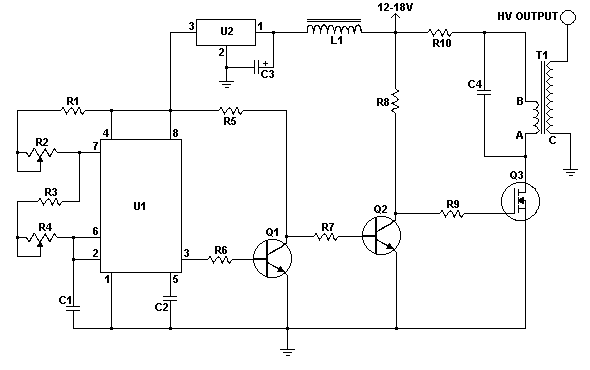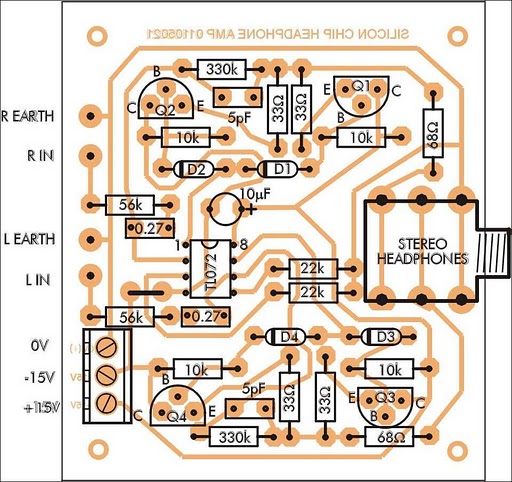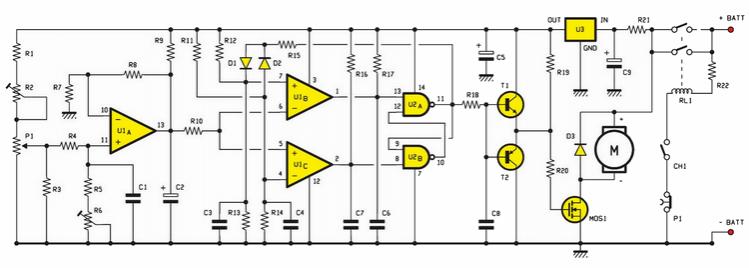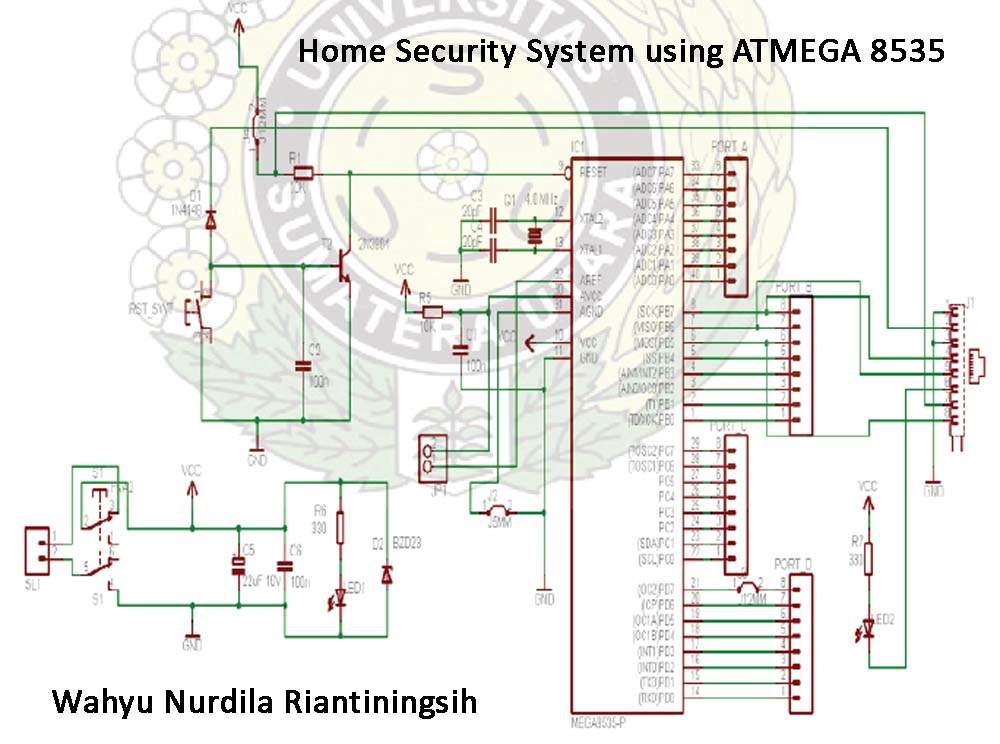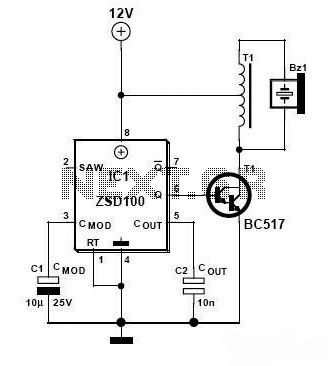
The FSK modulation circuit composed of 74LS74
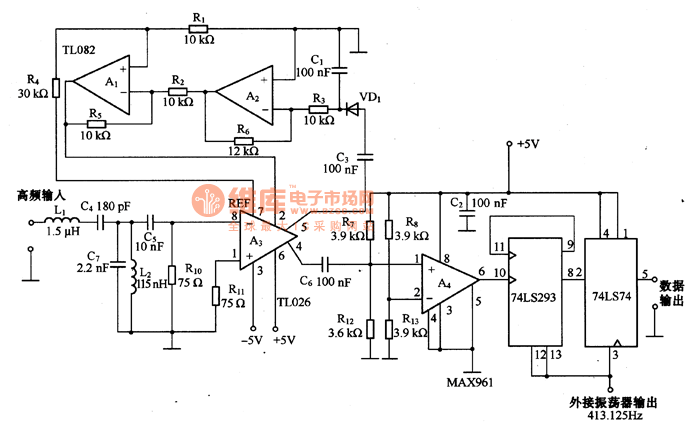
This is an FSK modulation circuit composed of the 74LS74. The FSK modulation circuit does not include a phase-locked loop (PLL) or a high-Q bandpass filter, eliminating the need for tuning adjustments in the high-frequency modulation circuit. The two tuning circuits, consisting of L1, L2, C4, and C7, function as an input filter, allowing only the frequency band with a central frequency of 10 MHz to pass through. The high-frequency difference amplifier A3 amplifies the 10 MHz signal. The automatic gain control (AGC) circuit is composed of A1 and A2. The high-frequency signal, amplified by A3, can be converted into a digital signal by comparator A4.
The FSK modulation circuit utilizing the 74LS74 flip-flop is designed for efficient frequency shift keying applications. The absence of a phase-locked loop (PLL) simplifies the design, making it more robust against variations in frequency due to environmental factors. The high-Q bandpass filter is also omitted, which further streamlines the circuit and reduces complexity.
The input filter, formed by the inductors L1 and L2 and capacitors C4 and C7, is critical in ensuring that only the desired frequency of 10 MHz is processed. This filter is designed to reject unwanted frequencies, thus enhancing the performance of the modulation circuit by minimizing noise and interference.
Amplifier A3 serves as a high-frequency difference amplifier, effectively increasing the amplitude of the 10 MHz signal, which is essential for subsequent processing stages. The gain provided by A3 is crucial for maintaining signal integrity and ensuring that the signal is strong enough for digital conversion.
The automatic gain control (AGC) circuit, comprising amplifiers A1 and A2, plays a vital role in maintaining consistent output levels despite variations in input signal strength. This feature is particularly important in communication systems where signal levels can fluctuate due to various factors, including distance and environmental conditions.
Finally, comparator A4 is employed to convert the amplified analog signal into a digital format. This conversion is essential for digital processing and ensures that the FSK modulation can be effectively utilized in digital communication systems. The overall design of the circuit emphasizes efficiency and reliability, making it suitable for a range of applications in modern electronics.This is the FSK modulation circuit composed of 74LS74. The FSK modulation circuit has neither PLL nor bandpass filter with high Q value, so there is no need of any tune adjustment in the high-frequency modulation circuit. The 2 tune circuits composed of L1, L2, C4 and C7 is working as the input filter, which only allows the frequency band with cen
tral frequency of 10MHZ to pass, and the high frequency difference amplifier A3 can amplify the 10MHZ signal. The auto gain control (AGC) circuit is composed of A1 and A2. The HF signal, which is magnified by A3, can be switched into digital signal by comparator A4. 🔗 External reference
The FSK modulation circuit utilizing the 74LS74 flip-flop is designed for efficient frequency shift keying applications. The absence of a phase-locked loop (PLL) simplifies the design, making it more robust against variations in frequency due to environmental factors. The high-Q bandpass filter is also omitted, which further streamlines the circuit and reduces complexity.
The input filter, formed by the inductors L1 and L2 and capacitors C4 and C7, is critical in ensuring that only the desired frequency of 10 MHz is processed. This filter is designed to reject unwanted frequencies, thus enhancing the performance of the modulation circuit by minimizing noise and interference.
Amplifier A3 serves as a high-frequency difference amplifier, effectively increasing the amplitude of the 10 MHz signal, which is essential for subsequent processing stages. The gain provided by A3 is crucial for maintaining signal integrity and ensuring that the signal is strong enough for digital conversion.
The automatic gain control (AGC) circuit, comprising amplifiers A1 and A2, plays a vital role in maintaining consistent output levels despite variations in input signal strength. This feature is particularly important in communication systems where signal levels can fluctuate due to various factors, including distance and environmental conditions.
Finally, comparator A4 is employed to convert the amplified analog signal into a digital format. This conversion is essential for digital processing and ensures that the FSK modulation can be effectively utilized in digital communication systems. The overall design of the circuit emphasizes efficiency and reliability, making it suitable for a range of applications in modern electronics.This is the FSK modulation circuit composed of 74LS74. The FSK modulation circuit has neither PLL nor bandpass filter with high Q value, so there is no need of any tune adjustment in the high-frequency modulation circuit. The 2 tune circuits composed of L1, L2, C4 and C7 is working as the input filter, which only allows the frequency band with cen
tral frequency of 10MHZ to pass, and the high frequency difference amplifier A3 can amplify the 10MHZ signal. The auto gain control (AGC) circuit is composed of A1 and A2. The HF signal, which is magnified by A3, can be switched into digital signal by comparator A4. 🔗 External reference
